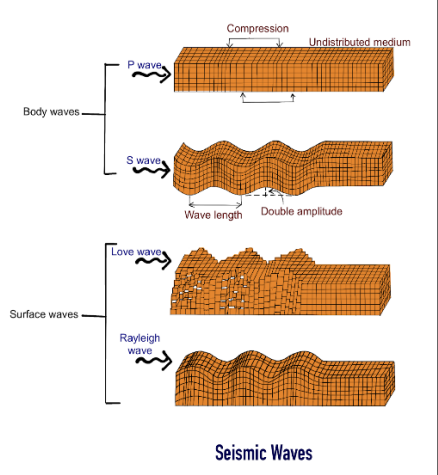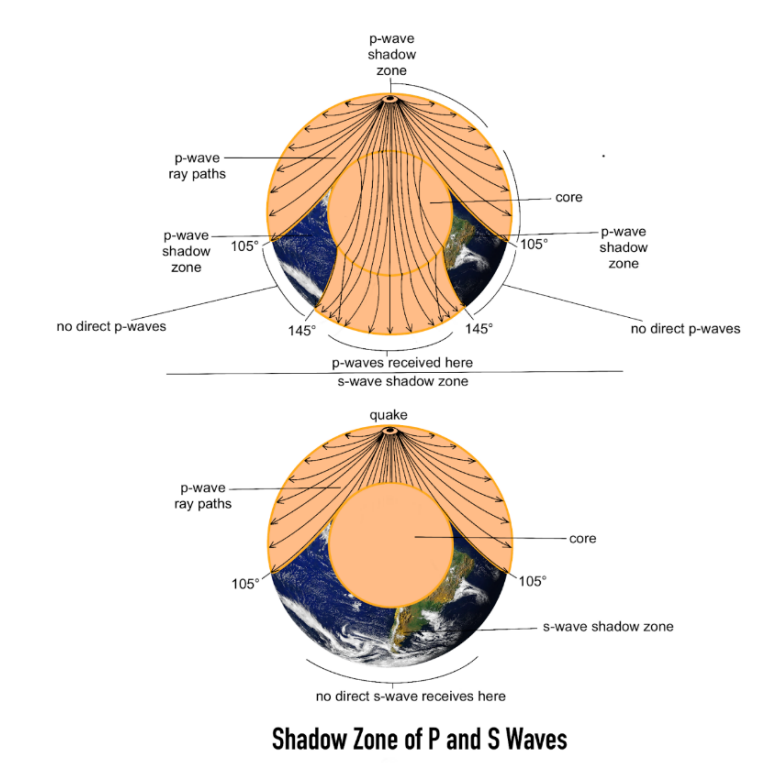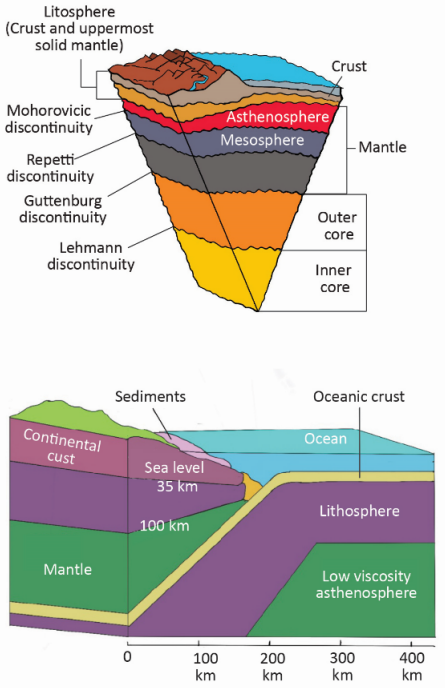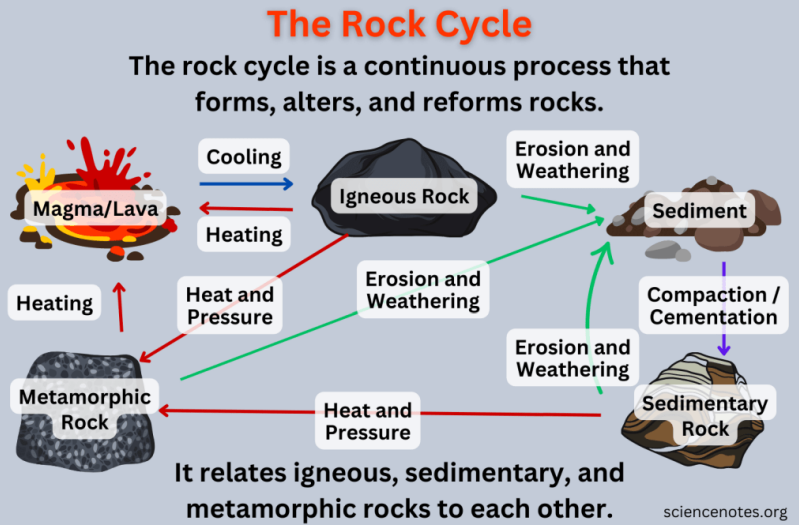Geography Playlist
19 chapters • 0 completed
The Universe and the Earth
18 topics
Atmosphere and its composition
6 topics
Atmospheric Temperature
11 topics
Atmospheric Moisture
9 topics
Air Mass, Fronts & Cyclones
15 topics
Evolution of Earths Crust, Earthquakes and Volcanoes
23 topics
Interior of The Earth
14 topics
Landforms
25 topics
Geomorphic Processes
10 topics
Movement of Ocean Water
16 topics
Oceans and its Properties
12 topics
Climate of a Region
14 topics
Indian Geography - introduction, Geology
5 topics
Physiography of India
27 topics
Indian Climate
20 topics
Indian Drainage
32 topics
Soil and Natural Vegetation
13 topics
Mineral and Energy Resources, Industries in India
28 topics
Indian Agriculture
22 topics
Chapter 7: Interior of The Earth
Chapter TestDifferent Spheres of the Earth & Earth’s Interior
Earth consists of five main spheres — Geosphere, Biosphere, Hydrosphere, Atmosphere, and Cryosphere — which interact to support life and natural processes. Studying Earth’s interior helps us understand its physical features, resources, climate history, and planetary similarities.
Earth consists of five main spheres — Geosphere, Biosphere, Hydrosphere, Atmosphere, and Cryosphere — which interact to support life and natural processes. Studying Earth’s interior helps us understand its physical features, resources, climate history, and planetary similarities.
Different Spheres of Earth
| Sphere | Description |
|---|---|
| Geosphere | Earth’s rocks, interior, and lithosphere |
| Biosphere | Supports living organisms |
| Hydrosphere | Oceans, rivers, lakes, and water bodies |
| Atmosphere | Air envelope surrounding Earth |
| Cryosphere | Frozen regions like ice caps and glaciers |
Importance of Studying Earth’s Interior
| Aspect | Reason |
|---|---|
| Physical features | Explains mountains, valleys, earthquakes, volcanoes |
| Life evolution | Geological timescale and fossils study |
| Resources | Minerals and energy exploration |
| Climate | Understanding past and future changes |
| Planetary comparison | Similarity with Mercury, Venus, Mars |
| Magnetic field | Explains Earth’s magnetism |
Mains Key Points
Prelims Strategy Tips
Sources of Information about Earth’s Interior
Our understanding of Earth's interior comes from both direct and indirect sources. Direct sources such as mining, drilling, volcanism, and surface rocks provide physical samples, while indirect sources such as meteorites, gravity, magnetism, and seismic waves provide large-scale insights. Together, these sources explain Earth’s layered structure, composition, and dynamic processes.
Our understanding of Earth's interior comes from both direct and indirect sources. Direct sources such as mining, drilling, volcanism, and surface rocks provide physical samples, while indirect sources such as meteorites, gravity, magnetism, and seismic waves provide large-scale insights. Together, these sources explain Earth’s layered structure, composition, and dynamic processes.
Direct Sources of Earth’s Interior
| Source | Details |
|---|---|
| Mining & Drilling | Samples from crust; projects like Deep Ocean Drilling & IODP; pressure-temperature-depth relations |
| Volcanism | Lava & gases reveal mantle minerals, deep processes, and mantle plumes |
| Surface Rocks | Outcrops, fossils, orogeny reveal shallow composition & tectonics |
Indirect Sources of Earth’s Interior
| Source | Details |
|---|---|
| Meteorites | Show primitive solar system material; evidence of differentiation; iron in Earth’s core |
| Gravitational Field | Anomalies indicate density variation; used in tectonics, mineral and oil exploration |
| Magnetic Field | Generated by core convection (geodynamo); paleomagnetism supports plate tectonics; reversals date rocks |
| Seismic Waves | P & S waves, shadow zones, and discontinuities reveal layered Earth (crust, mantle, core) |
Mains Key Points
Prelims Strategy Tips
Seismic Waves
Seismic waves are energy shockwaves released during earthquakes from the focus. They travel at different speeds through different materials, recorded by a seismometer as a seismogram. Seismic waves are of two main types: Body waves (inside Earth) and Surface waves (on Earth’s surface).
Seismic waves are energy shockwaves released during earthquakes from the focus. They travel at different speeds through different materials, recorded by a seismometer as a seismogram. Seismic waves are of two main types: Body waves (inside Earth) and Surface waves (on Earth’s surface).

Types of Seismic Waves
| Type | Characteristics |
|---|---|
| P-waves (Primary) | Fastest, compressional, travel through solids, liquids, gases |
| S-waves (Secondary) | Slower, transverse, only through solids, prove liquid outer core |
| Love Waves | Surface, horizontal side-to-side, highly destructive |
| Rayleigh Waves | Surface, rolling elliptical motion, cause swaying of structures |
Mains Key Points
Prelims Strategy Tips
Types of Seismic Waves – P, S and Surface Waves
Seismic waves are classified into body waves (P-waves and S-waves) and surface waves. P-waves are the fastest, compressional waves that move through solids, liquids, and gases. S-waves are slower, transverse, and travel only through solids. Surface waves are the slowest but most destructive, traveling along Earth’s surface.
Seismic waves are classified into body waves (P-waves and S-waves) and surface waves. P-waves are the fastest, compressional waves that move through solids, liquids, and gases. S-waves are slower, transverse, and travel only through solids. Surface waves are the slowest but most destructive, traveling along Earth’s surface.
Comparison of Seismic Waves
| Type | Speed | Medium | Particle Motion | Destructive Power |
|---|---|---|---|---|
| P-Waves | 5–14 km/sec (fastest) | Solids, liquids, gases | Parallel (push-pull) | Low damage |
| S-Waves | 3.5–7.2 km/sec (slower) | Only solids | Perpendicular (up-down) | Moderate damage |
| Surface Waves | Slowest | Surface only | Oblique (side-to-side / rolling) | Highest damage |
Mains Key Points
Prelims Strategy Tips
Types of Surface Waves – Love and Rayleigh Waves
Surface waves are the slowest but most destructive seismic waves, traveling along Earth’s surface. They include Love waves, which cause side-to-side ground motion, and Rayleigh waves, which cause elliptical rolling motion like ocean waves.
Surface waves are the slowest but most destructive seismic waves, traveling along Earth’s surface. They include Love waves, which cause side-to-side ground motion, and Rayleigh waves, which cause elliptical rolling motion like ocean waves.
Types of Surface Waves
| Type | Discovered/Predicted by | Motion | Key Features |
|---|---|---|---|
| Love Waves | A.E.H. Love (1911) | Horizontal (side-to-side) | Fastest surface wave, causes severe horizontal shearing |
| Rayleigh Waves | Lord Rayleigh (1885) | Elliptical (rolling) | Like ocean waves, cause vertical + horizontal displacement, highly destructive |
Mains Key Points
Prelims Strategy Tips
Emergence of Shadow Zone
The shadow zone is the region on Earth’s surface where seismic waves from an earthquake are not recorded. Careful seismograph observations show that S-waves completely disappear beyond 105°, and P-waves are absent between 105°–145°. These observations proved that Earth’s outer core is liquid, while the inner core is solid.
The shadow zone is the region on Earth’s surface where seismic waves from an earthquake are not recorded. Careful seismograph observations show that S-waves completely disappear beyond 105°, and P-waves are absent between 105°–145°. These observations proved that Earth’s outer core is liquid, while the inner core is solid.

Shadow Zones of Seismic Waves
| Wave Type | Shadow Zone Range | Cause |
|---|---|---|
| P-Waves | 105° – 145° | Strong refraction in liquid outer core |
| S-Waves | Beyond 105° (entire zone) | Cannot travel through liquid outer core |
Significance of Shadow Zones
| Observation | Inference |
|---|---|
| S-waves disappear beyond 105° | Outer core is liquid |
| P-waves slow down in 105°–145° | Outer core affects wave velocity |
| P-waves reappear beyond 145° with higher speed | Inner core is solid |
| Different shadow zones | Earth is layered, not homogeneous |
Mains Key Points
Prelims Strategy Tips
Comparison of Primary, Secondary and Surface Waves
Seismic waves differ in their speed, wavelength, direction, arrival time, and the medium they can travel through. P-waves are the fastest and first to arrive, S-waves follow with slower speed and shear motion, while surface waves are the slowest but most destructive.
Seismic waves differ in their speed, wavelength, direction, arrival time, and the medium they can travel through. P-waves are the fastest and first to arrive, S-waves follow with slower speed and shear motion, while surface waves are the slowest but most destructive.
Comparison of P, S, and Surface Waves
| Criteria | Primary Waves (P) | Secondary Waves (S) | Surface Waves |
|---|---|---|---|
| Time to reach surface | First to arrive | After P-waves | Last to arrive |
| Wavelength | Very short | Medium | Longest |
| Direction | Parallel (push-pull) | Perpendicular (shear) | Oblique (side-to-side/rolling) |
| Medium of travel | Solids, liquids, gases | Only solids | Surface (solid) only |
| Speed | Fastest (5–14 km/s) | Slower (3.5–7.2 km/s) | Slowest (3–5 km/s) |
| Destruction | Least destructive | Moderate destruction | Most destructive |
Mains Key Points
Prelims Strategy Tips
Structure of the Earth – Crust and E-Prime Layer
The Earth’s structure begins with the crust, its outermost and thinnest layer, composed of the continental crust (Sial) and oceanic crust (Sima). A distinct new discovery is the E-Prime layer at the outermost part of the Earth’s core, formed by long-term interaction of surface water with deep layers.
The Earth’s structure begins with the crust, its outermost and thinnest layer, composed of the continental crust (Sial) and oceanic crust (Sima). A distinct new discovery is the E-Prime layer at the outermost part of the Earth’s core, formed by long-term interaction of surface water with deep layers.
Comparison of Sial and Sima
| Aspect | Sial (Continental Crust) | Sima (Oceanic Crust) |
|---|---|---|
| Composition | Silica + Alumina | Silica + Magnesium |
| Rock Type | Granitic | Basaltic |
| Density | 2.7 g/cm³ (lighter) | 3.5 g/cm³ (denser) |
| Location | Forms continents | Forms ocean floors |
| Thickness | ≈ 30 km | ≈ 5 km |
Mains Key Points
Prelims Strategy Tips
Structure of the Earth – Mantle and Core (Detailed)
The mantle is the thickest layer of Earth, extending from the Moho discontinuity to 2,900 km. It is composed of silicate minerals and divided into upper and lower mantle, including special zones like asthenosphere and lithosphere. Below lies the metallic core (Nife), divided into a liquid outer core and solid inner core. The innermost inner core exhibits anisotropy, offering clues about Earth's deep processes and magnetic field generation.
The mantle is the thickest layer of Earth, extending from the Moho discontinuity to 2,900 km. It is composed of silicate minerals and divided into upper and lower mantle, including special zones like asthenosphere and lithosphere. Below lies the metallic core (Nife), divided into a liquid outer core and solid inner core. The innermost inner core exhibits anisotropy, offering clues about Earth's deep processes and magnetic field generation.

Mantle and Core – Extended Features
| Layer | Depth (km) | Temperature | Composition | Density (g/cm³) | State | Special Features |
|---|---|---|---|---|---|---|
| Upper Mantle | 403–660 | 500–900°C | Peridotite, silicates | 4.5 | Viscous solid | Less pressure, source of convection |
| Lower Mantle | 660–2891 | Up to 7400°C | Dense silicates | 4.5 | Solid | Supports mantle convection |
| Asthenosphere | Up to 500 | Variable | Partially molten silicates | Low | Ductile | Source of magma, allows plate movement |
| Lithosphere | 5–200 | Cooler | Crust + upper mantle | Light | Rigid | Forms tectonic plates |
| Outer Core | 2891–5100 | 4500–5500°C | Nickel + Iron (Nife) | 12.6–13 | Liquid | Generates magnetic field |
| Inner Core | 5100–6371 | ≈5200°C | Iron + Nickel | 9.9–12.2 | Solid | Anisotropic wave velocity |
| Innermost Inner Core | Central zone | 5500–6000°C | Iron + Nickel | High | Solid | Unique crystalline alignment, anisotropy |
Mains Key Points
Prelims Strategy Tips
Seismic Discontinuities of the Earth
Seismic discontinuities are boundaries inside the Earth where there is a sudden change in seismic wave velocity due to differences in density and composition of materials. These boundaries help in understanding Earth’s internal layering.
Seismic discontinuities are boundaries inside the Earth where there is a sudden change in seismic wave velocity due to differences in density and composition of materials. These boundaries help in understanding Earth’s internal layering.
Major Seismic Discontinuities
| Name | Transition Between | Depth (Approx.) | Significance |
|---|---|---|---|
| Conrad Discontinuity | Sial and Sima (within crust) | Varies (continental crust) | Distinguishes continental & oceanic crust |
| Mohorovičić (Moho) | Crust and Mantle | 5–10 km (oceanic), 35 km (continental) | Base of crust; sharp velocity change |
| Repetti Discontinuity | Upper and Lower Mantle | 700–800 km | Divides mantle into two zones |
| Gutenberg Discontinuity | Mantle and Core | 2,900 km | Outer core is liquid (S-wave disappears) |
| Lehmann Discontinuity | Outer and Inner Core | 5,100 km | Inner core is solid (P-wave speed increases) |
Mains Key Points
Prelims Strategy Tips
Temperature, Pressure, Density of Earth’s Interior & Magnetic Field
Temperature, pressure, and density increase with depth inside the Earth, influencing its structure and dynamics. The Earth’s liquid outer core, through the geodynamo effect, generates the magnetic field that protects life and guides navigation.
Temperature, pressure, and density increase with depth inside the Earth, influencing its structure and dynamics. The Earth’s liquid outer core, through the geodynamo effect, generates the magnetic field that protects life and guides navigation.
Temperature, Pressure, and Density of Earth’s Interior
| Depth | Temperature | Pressure | Density |
|---|---|---|---|
| Surface | 15°C (average) | 1 atm | ~2.7 g/cm³ (crustal rocks) |
| 100 km | 1200°C | 3 GPa | 3.0 g/cm³ |
| 700 km (Repetti) | ~2000°C | 23 GPa | 3.5–4 g/cm³ |
| 2900 km (Gutenberg) | 4000°C | 135 GPa | 5.5 g/cm³ |
| 5100 km (Lehmann) | 5000–5200°C | 330 GPa | 10–12 g/cm³ |
| 6371 km (Center) | 5500–6000°C | 364 GPa | 13–14 g/cm³ |
Mains Key Points
Prelims Strategy Tips
Earth’s Magnetic Phenomena: Polar Reversal, Magnetosphere, Radiation Belts, and Anomalies
Earth’s magnetic field is dynamic, shaped by core convection and solar wind interactions. Phenomena like polar reversal, magnetosphere shielding, Van Allen belts, geomagnetic storms, and anomalies like the South Atlantic Anomaly highlight the importance of geomagnetism in sustaining life and protecting technologies.
Earth’s magnetic field is dynamic, shaped by core convection and solar wind interactions. Phenomena like polar reversal, magnetosphere shielding, Van Allen belts, geomagnetic storms, and anomalies like the South Atlantic Anomaly highlight the importance of geomagnetism in sustaining life and protecting technologies.
Key Magnetic Phenomena
| Phenomenon | Description | Significance |
|---|---|---|
| Polar Reversal | Reversal of Earth’s magnetic poles over thousands of years | Explains alternating polarity in rocks; linked to convection changes in core |
| Magnetosphere | Region dominated by Earth’s magnetic field | Shields Earth from solar wind and cosmic rays |
| Van Allen Belts | Zones of trapped charged particles | Deflects harmful radiation, protects atmosphere |
| Geomagnetic Storm | Magnetospheric disturbance from solar wind/CME | Affects satellites, GPS, power grids, astronauts |
| South Atlantic Anomaly | Weak magnetic region between Africa & South America | Radiation risk to satellites and spacecraft |
Mains Key Points
Prelims Strategy Tips
Rocks and Minerals – Minerals and Their Types
Minerals are naturally occurring inorganic compounds with unique physical, chemical, and atomic properties. They form the building blocks of rocks and are classified into various types based on composition, such as silicates, carbonates, sulphides, and metallic minerals.
Minerals are naturally occurring inorganic compounds with unique physical, chemical, and atomic properties. They form the building blocks of rocks and are classified into various types based on composition, such as silicates, carbonates, sulphides, and metallic minerals.
Types of Minerals and Examples
| Type | Description | Examples |
|---|---|---|
| Silicate Minerals | Made of silicon and oxygen, most abundant group | Quartz, Feldspar, Mica, Olivine |
| Carbonate Minerals | Contain carbonate ions (CO₃²⁻) | Calcite, Dolomite |
| Sulphide Minerals | Contain sulphide/disulphide ions | Pyrite, Galena, Chalcopyrite, Zinc Blende |
| Metallic Minerals | Contain metals (ferrous/non-ferrous) | Iron, Manganese, Copper, Bauxite |
Mains Key Points
Prelims Strategy Tips
Rocks – Types, Characteristics, and Transformations
Rocks are natural aggregates of minerals that undergo formation and transformation through processes like cooling, sedimentation, and metamorphism. They are broadly classified into igneous, sedimentary, and metamorphic rocks, each with distinct properties, resources, and economic uses.
Rocks are natural aggregates of minerals that undergo formation and transformation through processes like cooling, sedimentation, and metamorphism. They are broadly classified into igneous, sedimentary, and metamorphic rocks, each with distinct properties, resources, and economic uses.

Types of Rocks – Comparison
| Feature | Igneous Rocks | Sedimentary Rocks | Metamorphic Rocks |
|---|---|---|---|
| Stratification | Absent | Present | Foliation/lineation present |
| Structure | Granular, crystalline | Layered, non-crystalline | Banded or foliated |
| Fossils | Absent | Present | Absent |
| Porosity | Least porous | Porous, permeable | Hard, less porous |
| Coverage | Less widespread | ~75% of surface | Localised |
| Resources | Metallic minerals | Coal, petroleum, natural gas | Marble, slate (building materials) |
Examples of Rock Transformations
| Original Rock | Type | Metamorphic Form |
|---|---|---|
| Limestone | Sedimentary | Marble |
| Dolomite | Sedimentary | Marble |
| Sandstone | Sedimentary | Quartzite |
| Shale | Sedimentary | Slate |
| Granite | Igneous | Gneiss |
| Slate | Metamorphic | Schist/Phyllite |
| Phyllite | Metamorphic | Schist |
Mains Key Points
Prelims Strategy Tips
Chapter Complete!
Ready to move to the next chapter?
